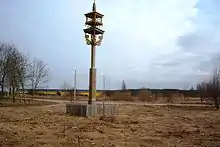
A roofed pole in Skaruliai village near Jonava.
Roofed pole or roofed pillar (Lithuanian: stogastulpis, plural: stogastulpiai, from stogas – 'roof' and stulpas – 'pole, pillar') is a traditional Lithuanian wooden shrine. They may have anywhere between one and three layers of stylized roofs. Roofed poles can be simple, or richly decorated.[1] Nowadays the most common ornamentation are a distinctive blend of Christian symbolism and traditional solar, celestial, and nature motifs.[2][3][4] Stogastulpiai, together with Lithuanian crosses, are common throughout Lithuania, and can be found in churchyards, village/town squares, cemeteries, farms, parks, in fields and woods, at cross-roads, and as wayside shrines.
 A roofed pole in the Švėkšna town center
A roofed pole in the Švėkšna town center A roofed pole tipped with an ornate iron cross with floral motif. Angiras village, northwest of Josvainiai.
A roofed pole tipped with an ornate iron cross with floral motif. Angiras village, northwest of Josvainiai. A roofed pole near Alkas, Kretinga district, Lithuania.
A roofed pole near Alkas, Kretinga district, Lithuania. A roofed pole near Savarina village, Mažeikiai district, Lithuania. Note snake motif of roof "supports."
A roofed pole near Savarina village, Mažeikiai district, Lithuania. Note snake motif of roof "supports."
See also
References
- ↑ Senoji lietuvių skulptūra, kryžiai ir koplytėlės (Old Lithuanian sculpture, crosses, and shrines)
- ↑ Gimbutas, Marija (1958). Ancient symbolism in Lithuanian folk art. Bloomington, IN: American Folklore Society. OCLC 1106451.
- ↑ Grinius, Jonas (1956). "Crosses". Lituanus. 8 (3).
- ↑ Algirdo Šalkausko stebuklai iš medžio
This article is issued from Wikipedia. The text is licensed under Creative Commons - Attribution - Sharealike. Additional terms may apply for the media files.